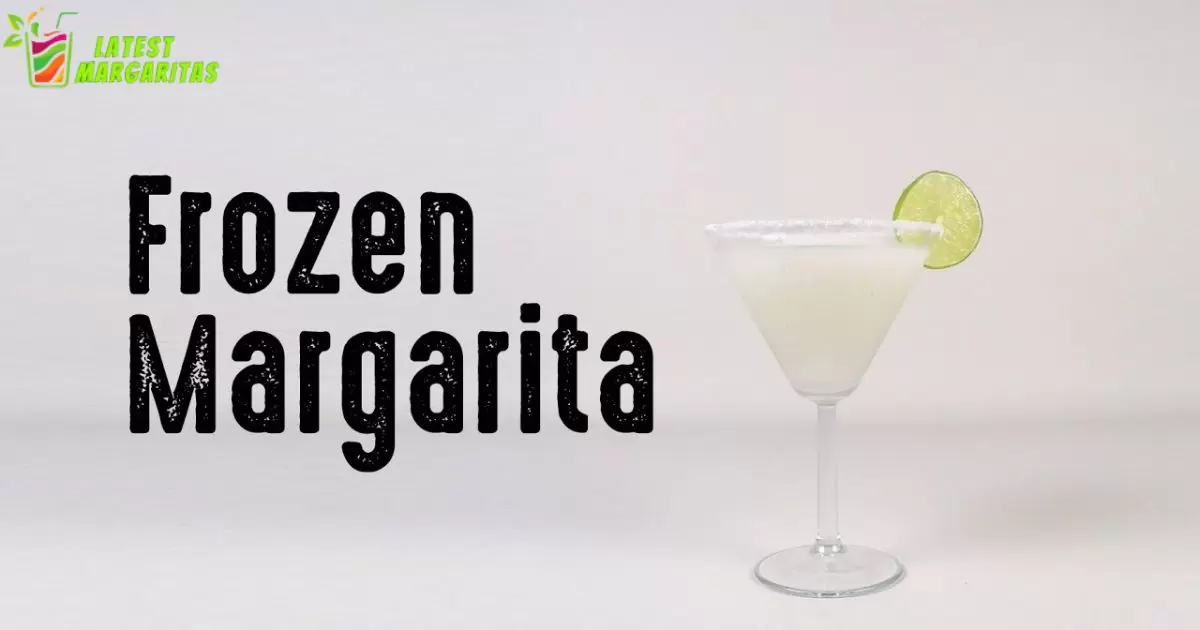Carbs in a frozen margarita primarily come from the alcohol, such as tequila and triple sec, as well as any sweeteners and mixers used. The total carb content can vary widely depending on the recipe and serving size, making it essential to be mindful of ingredient proportions and potential flavor additives when calculating the carb count. Understanding the carbohydrate content of a frozen margarita is important for individuals monitoring their carb intake and dietary choices.
Carbs in a frozen margarita mainly stem from the alcohol, sweeteners, and mixers. The carb content can vary, so it’s important to consider ingredient proportions and serving sizes when assessing its impact on your diet.
Understanding Frozen Margaritas
A frozen margarita typically consists of four primary ingredients.frozen margaritas requires knowledge of the key ingredients, such as tequila, triple sec, lime juice, and sweeteners, as well as the blending process that gives this classic cocktail its signature icy texture.
Tequila
Tequila is the alcoholic backbone of any margarita. It is made from the fermented and distilled juices of the blue agave plant. The carb content in tequila is relatively low, as it is distilled, which removes most of the sugars. On average, a standard shot (1.5 ounces) of tequila contains about 0 grams of carbs.
Triple Sec
Triple sec is an orange-flavored liqueur that adds sweetness and flavor to the margarita. While it does contribute some carbs, it’s usually a small amount, roughly 11 grams of carbs per ounce. However, some variations may have lower-carb alternatives or sugar-free options.
Lime Juice
Lime juice provides the tart and zesty taste that is characteristic of a margarita. Lime juice contains some carbs, but these are generally low, with around 2 grams of carbs per ounce. This ingredient is not a significant contributor to the overall carb count.
Sweetener
Sweeteners like simple syrup or agave nectar are often used to balance the flavors and sweetness of a margarita. Depending on the amount used, sweeteners can add a considerable number of carbs. It’s essential to be mindful of the sweetener used and the quantity when calculating carb content.
Preparation Process
To create a classic frozen margarita, the ingredients are blended with ice until the mixture reaches a slushy consistency. It’s important to note that the proportion of ingredients and the type of sweetener used can vary, affecting the overall carb content.
Carbohydrates in Frozen Margaritas
The carbohydrates in frozen margaritas primarily come from the alcohol, mixers, and sweeteners used in the recipe. Tequila and triple sec contribute to the carb content, while lime juice and any added sweeteners add minimal carbs. Calculating the total carbohydrate content is essential for those monitoring their carb intake or managing dietary choices.
| Nutrient | Amount per 1 Drink |
| Total Carbs | 12.2g |
| Net Carbs | 11.9g |
| Fat | 0.2g |
| Protein | 0.1g |
| Calories | 218 |
This table provides the nutritional content for one frozen margarita, including total carbs, net carbs, fat, protein, and total calories.
Carbs from Alcohol
Alcohol contributes to the carb content of a margarita. The primary sources of carbs from alcohol in a margarita are tequila and triple sec.
Tequila
As mentioned earlier, a standard shot of tequila contains minimal carbs, roughly 0 grams. However, when you have multiple shots in your margarita, the carb count can add up.
Triple Sec
Triple sec, being a liqueur, contains a higher carb content, approximately 11 grams per ounce. If you’re using a standard serving, it’s important to account for this in your carb calculations.
Carbs from Mixers
In addition to alcohol, the mixers used in a margarita can also contribute to its carbohydrate content.
Lime Juice
Lime juice adds a touch of acidity and flavor to the margarita. With approximately 2 grams of carbs per ounce, lime juice is a minor contributor to the total carb count.
Sweetener
Sweeteners can vary in type and quantity, impacting the carb content. For example, a margarita made with a sugar-free sweetener will have fewer carbs than one made with regular simple syrup or agave nectar.
Total Carbohydrate Content
To determine the total carb content in a frozen margarita, you need to consider the carb content of each ingredient and the serving size. It’s important to be mindful of the proportions and the variations used in different recipes.
Approximate Carbohydrate Content in a Standard Frozen Margarita
| Ingredient | Carb Content (per 1.5 oz shot) |
| Tequila | 0 grams |
| Triple Sec | 11 grams |
| Lime Juice | 2 grams |
| Sweetener | Varies |
| Ice and other mixers | Minimal |
| Total (Standard Margarita) | Varies |
The total carb content in a frozen margarita can range widely based on the amount of sweetener used and the specific recipe. It’s important to keep track of the carb content to make informed dietary choices.
Variations in Carb Content
Variations in carb content can significantly impact the nutritional value of a frozen margarita. Factors like the choice between homemade and store-bought mix, flavor additions, and differences in serving size all play a role in determining the carb content. Low carb Margaritas are a great choice for those watching their carb intake. Traditional Margaritas can be high in carbs due to the sugary mixers, but there are ways to enjoy this cocktail with fewer carbs.
Homemade vs. Store-Bought Mix
The carb content in your margarita can differ significantly depending on whether you use a store-bought margarita mix or make your own. Store-bought mixes may contain added sugars and artificial ingredients, potentially increasing the carb count. Making your own mix allows you to control the ingredients and choose lower-carb options.
Flavor Additions
Some margaritas come with flavor additions like strawberry, mango, or coconut. These flavors may introduce additional sugars and carbs. If you’re looking to reduce your carb intake, it’s advisable to opt for the classic lime margarita.
Serving Size Differences
The serving size of a margarita can vary, from a standard 8-ounce glass to larger portions at restaurants and bars. Be mindful of the serving size when calculating your carb intake. Larger servings will naturally contain more carbs.
Low-Carb Alternatives
Opting for low-carb alternatives when enjoying a frozen margarita can be a wise choice for those watching their carbohydrate intake.
Using Sugar Substitutes
For those seeking a low-carb margarita, using sugar substitutes like stevia, erythritol, or monk fruit sweetener can help reduce the carb content while maintaining sweetness. Be sure to check the carb content of your chosen sugar substitute.
Fresh Lime Juice vs. Pre-made Mix
Opting for fresh lime juice instead of pre-made margarita mix can reduce the carb content and provide a fresher, more authentic flavor. Fresh lime juice typically has fewer added sugars and carbs compared to pre-made mixes.
Skinny Margarita Options
Many establishments offer “skinny” margaritas, which are lower in calories and carbs. These versions often use light or diet mixers and minimal sweetener. Choosing a skinny margarita can be a good option for those watching their carb intake.
Impact on Diet and Health

Understanding the impact of frozen margaritas on diet and health is crucial for making responsible and informed choices when enjoying this popular cocktail.
Carb Considerations for Diabetics
Individuals with diabetes need to be particularly cautious about their carbohydrate intake. Knowing the carb content of a frozen margarita is essential for managing blood sugar levels. If you have diabetes, consider consulting with a healthcare professional before enjoying a margarita.
Carbs and Weight Management
For those who are mindful of their carb intake for weight management, it’s important to consider the carb content of alcoholic beverages like margaritas. Moderation and informed choices are key to achieving dietary goals.
Responsible Drinking
Lastly, while considering the carb content of a margarita, it’s crucial to remember the importance of responsible drinking. Consuming alcoholic beverages should always be done in moderation to ensure your safety and well-being.
FAQs
Which is healthier beer or margarita?
Beer is typically healthier than a margarita when it comes to calorie and sugar content, but moderation is key for both.
What is the lowest calorie cocktail?
The lowest-calorie cocktail is often a simple vodka soda or a classic mojito without added sugars and syrups.
What cocktail has the least carbs?
The cocktail with the least carbs is typically a simple vodka or gin with calorie-free mixers like soda water or diet tonic.
What alcohol can I drink on a diet?
On a diet, opt for clear spirits like vodka, gin, or tequila with low-calorie mixers, and be mindful of portion sizes.
What drinks are zero calories for weight loss?
Drinks like water, unsweetened tea, and black coffee are zero calories and can aid in weight loss when consumed as part of a balanced diet.
Conclusion
The carbohydrate content of a frozen margarita is essential for those who are mindful of their dietary choices and health. The carb content can vary significantly based on the ingredients and variations used, making it vital to be aware of portion sizes and sweetener selections. Balancing the enjoyment of this classic cocktail with responsible drinking and dietary goals is key.
Comparing margaritas to beer, it’s important to note that beer generally has fewer calories and less sugar, making it a somewhat healthier choice. Moderation is crucial in both cases, especially when enjoying margaritas in a gallon, to maintain a balanced and responsible approach to alcohol consumption.
When on a diet, selecting low-carb and low-calorie cocktails can help you enjoy a drink while staying on track with your weight management goals. Ultimately, whether you prefer a frosty margarita or a crisp beer, making informed choices and practicing moderation ensures that you can savor your drink while prioritizing your well being.





